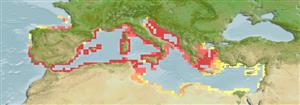分類 / Names
俗名 | 同種異名 | Catalog of Fishes(屬, 種) | ITIS | CoL | WoRMS | Cloffa
Teleostei >
Blenniiformes (Blennies)
鱸形目 (Blennies) >
Blenniidae (Combtooth blennies)
鳚科 (Combtooth blennies) > Salariinae
Etymology: Parablennius: Greek, para = the side of + Greek, blennios = mucus (Ref. 45335).
Environment: milieu / climate zone / depth range / distribution range
生態學
海洋 居於水底的; 深度上下限 0 - 42 m (Ref. 5981). 亞熱帶的; 46°N - 30°N, 11°W - 36°E
Northeast Atlantic: off Portugal. Also known from the northern Mediterranean.
東北大西洋: 葡萄牙外海。 也已知來自地中海北部。
大小 / 重量 / 年齡
Maturity: Lm ? range ? - ? cm
Max length : 8.0 cm TL 雄魚/尚未辨別雌雄; (Ref. 5981)
Facultative air-breathing in the genus (Ref. 126274); Adults occur in the shallow littoral zone to the zone beyond the influence of water movements, over light rocks or pebbles without algal cover and on secondary hard bottoms of coralligenous origin. They feed on periphyton, harpacticoids and algae. Males inhabit narrow piddock holes; they court by nodding, jumping out of hole and back again and swimming in a vertical position. Rivals are threatened by yawning, lateral display and circling, and are attacked by ramming and biting. Reproduction takes place from May to July. Attracted females spawn in resident hole of a males which guards eggs from several families (Ref. 5981). Oviparous. Eggs are demersal and adhesive (Ref. 205), and are attached to the substrate via a filamentous, adhesive pad or pedestal (Ref. 94114). Larvae are planktonic, often found in shallow, coastal waters (Ref. 94114).
出現於水淺的海濱區域到區域超過水運動的影響力, 光岩石之上或者沒有藻類覆蓋的小圓石與在 coralligenous 起源的第二堅硬底部上。 吃固著生物,猛水蚤與藻類。 棲息於狹窄的海筍洞的雄性; 他們求愛點頭的, 跳躍離洞而且再一次回來而且在一個垂直的位置中游泳。 對手被受到威脅的由於打哈欠, 側部顯示而且包圍, 而且被藉由力擊而且咬攻擊。 繁殖發生從五月到七月。 吸引雌性產卵於防止一些該科以保衛卵的雄性的定居洞中.(參考文獻 5981)
Life cycle and mating behavior
Maturities | 繁殖 | Spawnings | Egg(s) | Fecundities | 仔魚
Oviparous, distinct pairing (Ref. 205).東北大西洋: 葡萄牙外海。 也已知來自地中海北部。
Zander, C.D., 1986. Blenniidae. p. 1096-1112. In P.J.P. Whitehead, M.-L. Bauchot, J.-C. Hureau, J. Nielsen and E. Tortonese (eds.) Fishes of the North-eastern Atlantic and the Mediterranean, volume 3. UNESCO, Paris. (Ref. 5981)
人類使用
工具
特別的報告
下載 XML
網路資源
Estimates based on models
Preferred temperature (Ref.
123201): 16.5 - 19.5, mean 18.1 °C (based on 54 cells).
Phylogenetic diversity index (Ref.
82804): PD
50 = 0.5000 [Uniqueness, from 0.5 = low to 2.0 = high].
Bayesian length-weight: a=0.00741 (0.00335 - 0.01640), b=3.02 (2.83 - 3.21), in cm total length, based on LWR estimates for this (Sub)family-body shape (Ref.
93245).
營養階層 (Ref.
69278): 3.0 ±0.0 se; based on diet studies.
回復力 (Ref.
120179): 高度, 族群倍增時間少於 15個月 (Preliminary K or Fecundity.).
Fishing Vulnerability (Ref.
59153): Low vulnerability (10 of 100).
Nutrients (Ref.
124155): Calcium = 295 [156, 644] mg/100g; Iron = 1.6 [1.0, 3.0] mg/100g; Protein = 18.1 [17.1, 19.1] %; Omega3 = 0.263 [0.141, 0.481] g/100g; Selenium = 20 [9, 43] μg/100g; VitaminA = 22.1 [6.4, 74.0] μg/100g; Zinc = 1.51 [0.99, 2.22] mg/100g (wet weight);
